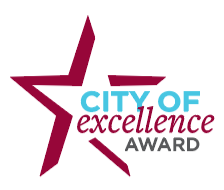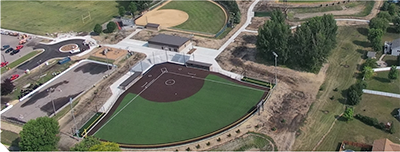Mankato Unveils Premier Softball Complex After Years of Community Advocacy and Input

By Deborah Lynn Blumberg
In southern Minnesota, generations of Mankato Peppers have unleashed fastballs and stolen bases, honing their skills and strengthening the community. But for years, the storied girls’ softball teams ranging in age from five to 18 shared city-owned diamonds in Mankato’s Thomas Park, which was originally built for baseball in the 1970s.
When the park’s five fields aged beyond simple repairs, the city built a new six-field youth baseball facility across town in 2015. Meanwhile, softball players continued using Thomas Park. Frustration grew among players, parents, coaches, youth softball league officials, and other community members, who had long advocated for a dedicated softball space for the Peppers and other players. The softball players needed a modern, reliable space where games and practices weren’t at risk of cancellation because of persistent drainage problems. The City of Mankato listened.
With funding secured from sales taxes, the city launched a $6 million effort to revamp the sports facility for softball, modernizing and upgrading the Thomas Park fields. Mankato was one of the recipients of the League of Minnesota’s 2024 City of Excellence Awards for its softball fields initiative, winning for its “Creative Involvement of City Residents.”
“This project has been a really positive improvement for the neighborhood, for tournament needs, and for the community’s softball field needs,” said Facilities Recreation Coordinator Claudia Hicks, who was hired to facilitate communication between stakeholders and city officials. “It was really exciting to see it all come together, and people are loving using the space.”
Community input shaped the design
When Mankato officials decided in 2019 to convert Thomas Park into a state-of-the-art softball complex, they prioritized community collaboration. Gathering input from stakeholders ensured that the final product met the needs of players and nearby residents.
Mankato’s public information team created a Communication and Engagement Action Plan and set goals for community participation. They set and reached their goal of a 30% feedback rate from neighborhood households (34 addresses) and input from 15% of ball field users.

As design planning got underway, board members from the Mankato Area Girls Fastpitch Association (MAGFA) were invited to walk the old softball complex and discuss needed upgrades. City officials also frequently engaged with Mankato Area Public Schools, Mankato Community Education, Bethany Lutheran College (whose players now use the new field), and residents in the surrounding neighborhoods.
Early feedback helped shape critical aspects of the facility, Hicks said. For example, stakeholders identified the need for designated team rooms, additional storage, warm-up areas, and additional accessible spectator seating.
Multiple conversations with nearby residents revealed a desire for greater field access beyond youth leagues, including more availability for community recreation, women’s softball leagues, and school district use. They also shared concerns about parking, noise, fencing, trees, traffic, and drainage. The city incorporated their feedback into updated design plans.
“People started to get excited about some of the upgrades that were going to be made,” Hicks said, including improving drainage, which benefited both the facility and nearby homes. New sidewalks connected the park more seamlessly to the adjacent neighborhood, making the area more accessible for pedestrians, runners, and cyclists.
The project faced challenges, including pandemic-related delays, cost increases, two rounds of project bidding, and difficult weather conditions. Officials also had to make hard decisions related to project cuts in order to stay in budget.
Despite these hurdles, the initiative got back on track in 2021, and construction kicked off in 2022. The city continued to work closely with stakeholders. Officials invited youth league board members to don hard hats and tour the ball complex during construction, and continued to solicit regular feedback on the project’s progress.
“For any tweaks or last-minute changes needed, they knew they could have a voice,” Hicks said.
Addressing parking and maximizing use
Because the complex shares parking with adjacent Mankato East High School and nearby protected greenspaces prevented expansion, parking coordination became a top priority. Hicks worked closely with the high school’s athletic director to balance field use and school events, ensuring smooth operations.
The redesigned facility features four youth tournament practice fields arranged in a pinwheel layout, converted from the previous three. A former 300- foot adult softball field was transformed into an artificial turf NCAA-compliant field with lights, concrete masonry dugouts, a scoreboard, and bleachers. Other additions include new trails and paved walking paths, batting cages, and new water detention ponds for storm water management.
The premier softball facility made its debut in July 2024 during Mankato’s largest softball tournament of the year, the Fourth of July Tournament.
“Stress-testing a brand-new facility with a giant tournament was a little nerve-racking,” said Hicks. “But fortunately, it went remarkably well.”
Continued engagement and future enhancements
During the event, project planners observed how attendees navigated the space and made final adjustments before permanent signage was installed. “We wanted to get feedback and make sure we had signs in the right spots,” Hicks said. “When you finish any project, you have little nips and tucks here and there.”
One discovery was that attendees gravitated toward a narrower path instead of the wider, more central walkway. In response, officials increased signage to alert people to the option of the wider path.
Weeks later, on July 25, Mankato opened its facility to the public with a grand opening. City Council members and stakeholders attended the festivities.
Since then, Thomas Park has hosted nearly 1,000 events, including 20 softball tournaments. Hundreds of softball players from around the state and region — from ages five and up — have practiced and competed on the modernized fields.
“The youth softball community has waited a long time for a facility that they could call home and be proud of, and the reception has been positive,” said Mankato Director of Administrative Services Parker Skophammer.
Players, their families, and coaches are thrilled with the new amenities, Hicks said, including a new concessions and restroom building with multiple restroom stalls for men and women, an inclusive restroom with an adult changing table, environmentally friendly low-flow restroom fixtures, two team rooms, and ample storage space for the city and users. A second building in the pinwheel provides additional restrooms.
“Teams love coming to Mankato to play at Thomas fields,” said Mankato Peppers President Marty Ray. “We get teams from Canada, Iowa, Wisconsin, South Dakota, and North Dakota for our tournaments, and they rave about how great it is to play at such a nice facility. The Mankato Peppers appreciate the work the city has put in, and continues to put in, to offer us such a great place for women’s sports.”
Spectators have also enjoyed new features, including wireless control scoreboards, LED lighting, a championship scoreboard at the artificial turf field, specialty lighting controls on the adult field, power outlets along spectator areas, picnic table seating, and the more than 600 new trees and shrubs planted as part of the project.
Since the fields reopened, the city has continued to check in with players, coaches, and youth softball league board members for feedback on additional improvements. For example, users have suggested adding shade structures to the pinwheel area and a portable concession stand at the park’s north end. Dialogue with stakeholders will be ongoing, Hicks said.
“It’s so crucial to make sure that engagement process is really strong up front, throughout the project, and even after it ends,” she said. “Just because you think you know what your user group needs doesn’t mean you don’t have to talk to them.”
Deborah Lynn Blumberg is a freelance writer.


